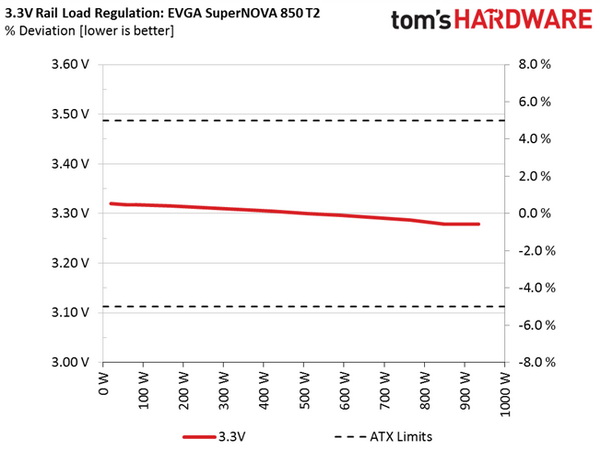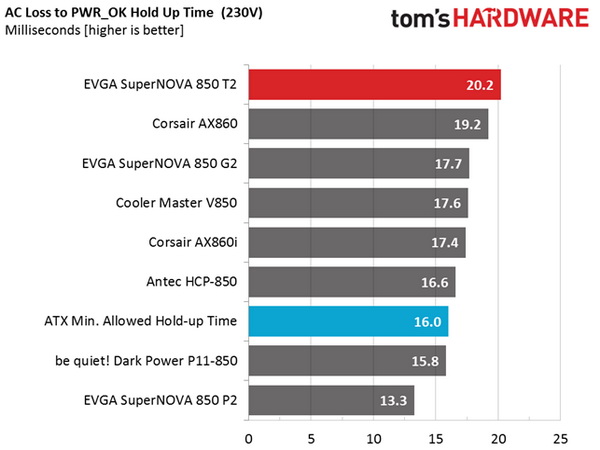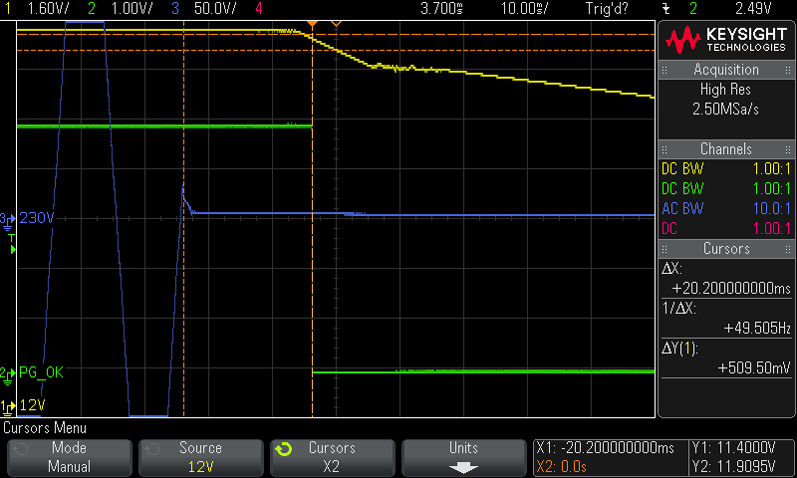EVGA SuperNOVA 850 T2 Power Supply Review
EVGA's T2 series consists of Titanium-rated PSUs with capacities ranging from 750 to 1600W. Today, we're looking at the 850W model, which tries to prove it is worth a premium compared to the company's Platinum-rated 850W offering.
Why you can trust Tom's Hardware
Load Regulation, Hold-Up Time And Inrush Current
To learn more about our PSU tests and methodology, please check out How We Test Power Supply Units.
Primary Rails And 5VSB Load Regulation
Load Regulation testing is detailed here.








Hold-Up Time
Our hold-up time tests are described in detail here.







The measured hold-up time is significantly longer than the ATX spec's minimum requirement, so everything's fine here. The same applies to the power-good signal. Disturbingly, we've seen a lot of high-end PSUs fail these crucial tests, including the SuperNOVA 850 P2. It's obviously a relief that at least the top Leadex platform isn't plagued by the same issues.
Inrush Current
For details on our inrush current testing, please click here.


The inrush current with 115V is low for a 850W PSU, while with 230V is normal.
Load Regulation And Efficiency Measurements
The first set of tests explores voltage rail stability and efficiency. The applied load equals (approximately) 10 to 110 percent of the supply's maximum in increments of 10 percentage points.
Get Tom's Hardware's best news and in-depth reviews, straight to your inbox.
We conducted two additional tests. During the first, we stressed the two minor rails (5V and 3.3V) with a high load, while the load at +12V was only 0.10A. This test reveals whether a PSU is Haswell-ready or not. In the second test, we determined the maximum load the +12V rail could handle with minimal load on the minor rails.
| Test # | 12V | 5V | 3.3V | 5VSB | DC/AC (Watts) | Efficiency | Fan Speed (RPM) | Noise (dB[A]) | Temps (In/Out) | PF/AC Volts |
|---|---|---|---|---|---|---|---|---|---|---|
| 1 | 5.169A | 1.983A | 1.988A | 0.981A | 84.78 | 89.79% | 0 | 0 | 45.43 °C | 0.945 |
| 12.226V | 5.040V | 3.318V | 5.091V | 94.42 | 37.55 °C | 115.1V | ||||
| 2 | 11.360A | 2.969A | 2.984A | 1.180A | 169.64 | 92.76% | 0 | 0 | 47.18 °C | 0.976 |
| 12.219V | 5.034V | 3.315V | 5.081V | 182.88 | 38.55 °C | 115.1V | ||||
| 3 | 17.918A | 3.478A | 3.499A | 1.375A | 254.87 | 93.70% | 0 | 0 | 48.24 °C | 0.988 |
| 12.212V | 5.029V | 3.312V | 5.074V | 272.00 | 39.40 °C | 115.1V | ||||
| 4 | 24.464A | 3.981A | 3.989A | 1.575A | 339.76 | 93.83% | 0 | 0 | 49.62 °C | 0.994 |
| 12.205V | 5.024V | 3.308V | 5.066V | 362.10 | 40.26 °C | 115.1V | ||||
| 5 | 30.669A | 4.978A | 4.990A | 1.775A | 424.61 | 93.59% | 0 | 0 | 51.30 °C | 0.995 |
| 12.200V | 5.018V | 3.305V | 5.058V | 453.68 | 41.19 °C | 115.1V | ||||
| 6 | 36.898A | 5.983A | 5.998A | 1.980A | 509.71 | 93.20% | 0 | 0 | 54.06 °C | 0.996 |
| 12.194V | 5.012V | 3.300V | 5.049V | 546.90 | 42.10 °C | 115.1V | ||||
| 7 | 43.120A | 6.997A | 7.008A | 2.180A | 594.61 | 92.68% | 620 | 20.8 | 43.67 °C | 0.997 |
| 12.187V | 5.005V | 3.296V | 5.040V | 641.59 | 58.36 °C | 115.1V | ||||
| 8 | 49.369A | 8.002A | 8.019A | 2.385A | 679.56 | 92.09% | 940 | 30.2 | 44.94 °C | 0.998 |
| 12.177V | 4.999V | 3.292V | 5.030V | 737.90 | 55.46 °C | 115.1V | ||||
| 9 | 56.059A | 8.507A | 8.548A | 2.385A | 764.58 | 91.48% | 940 | 30.2 | 45.28 °C | 0.998 |
| 12.166V | 4.994V | 3.287V | 5.026V | 835.79 | 56.12 °C | 115.1V | ||||
| 10 | 62.699A | 9.028A | 9.054A | 2.488A | 849.45 | 90.92% | 1315 | 41.7 | 47.19 °C | 0.998 |
| 12.157V | 4.989V | 3.279V | 5.020V | 934.29 | 58.26 °C | 115.1V | ||||
| 11 | 69.732A | 9.031A | 9.059A | 2.490A | 934.38 | 90.54% | 1315 | 41.7 | 47.68 °C | 0.998 |
| 12.149V | 4.985V | 3.278V | 5.016V | 1032.05 | 59.26 °C | 115.1V | ||||
| CL1 | 0.099A | 12.009A | 12.005A | 0.003A | 101.14 | 86.26% | 940 | 30.2 | 45.29 °C | 0.962 |
| 12.232V | 5.017V | 3.304V | 5.096V | 117.25 | 53.53 °C | 115.1V | ||||
| CL2 | 70.794A | 1.002A | 1.003A | 1.002A | 873.67 | 91.43% | 1315 | 41.7 | 46.89 °C | 0.998 |
| 12.152V | 5.006V | 3.284V | 5.059V | 955.57 | 55.05 °C | 115.1V |
Load regulation on the +12V and 5VSB rails is tight. The 5V and 3.3V rails are a little above 1%, so they're pretty good. Efficiency is very high in all of the tests, and the PSU satisfies the stringent 80 PLUS Titanium requirements in the 20% and full load tests. It comes close in the 10% and 50% measurements. But given the high temperatures inside our hot-box during testing, we will definitely give the 850 T2 a pass; it rightfully deserves its Titanium badge.
Our readings look good in the noise output benchmarks as well. At up to 60% load, the PSU operates passively. And at up to 90% the fan spins slowly, generating minimal noise. It's only during the full load and overload tests that the fan hits 100% duty cycle and we measure close to 42 dB(A). Under normal operating conditions, though, you won't see the fan spin. When it does start turning, you probably won't hear it.
Current page: Load Regulation, Hold-Up Time And Inrush Current
Prev Page A Look Inside And Component Analysis Next Page Efficiency, Temperature And Noise
Aris Mpitziopoulos is a contributing editor at Tom's Hardware, covering PSUs.
-
turkey3_scratch Very great unit, as expected. I would have liked to see the threshold for when OTP really kicks in, if it even does. Perhaps duct taping the exhaust grill will do the trick. It's nice to see Superflower use a MOV for a change. I just wish that 3.3V rail would not get so near 3.14V during the transient response tests, but realistically I don't expect the 3.3V rail to get that sudden load these days.Reply
Also @Aris, are you sure there's only 4 y caps? I thought those blue sleeves store multiple y caps? Or do they not? -
Aris_Mp if you mean the blue components before/after the bridge rectifier, they are X caps and I didn't count them in the EMI filter on purpose.Reply -
ZeusGamer I've had the G2 model of this power supply and it's still working great after two years. I'm really impressed by EVGA with these G2 and T2 models.Reply -
JackNaylorPE Efficiency is nice... I guess .... but with that 3.3 and 5V performance, I'm not impressed.Reply -
Dark Lord of Tech 3.3 rail can vary per unit , doesn't worry me a bit. Every test model for a review can produce different results.Reply -
JackNaylorPE To each his own I guess... but for the ridiculous price of $240, I'd want better. The Corsair 860 and coolermaster V850 PSUs finish 1 and 2 and are much cheaper.Reply
The unit would fail to meet the ATX spec at 5%, and this comes in at a rather dismal 4.5 %... yes, this does vary from unit to unit (and this is a bad thing) If the unit that winds up in the hands of a review site gets two outta 3 rails at 4.5%, I shudder to think what we might get ordering off newegg. In the review graphs, it's the bottom of the chart against all the other PSUs with which its compared.
The focus on efficiency in the ranking of PSUs in an enthusiast box is a criteria which escapes me ... I never walked into a Porsche dealership where the salesman's first pitch was "this model is great, it has the best gas mileage in our entire line'. -
yyk71200 Differences in effissiency between gold, platinum, and titanium psus are rather small and do not justify price differences. Quality of output is more important criteria in choosing a psu than small differences in wattage consumed.Reply


